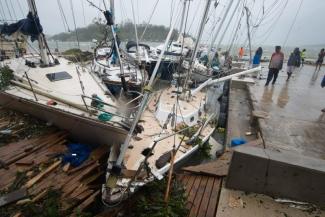Nansen Initiative
The Nansen Initiative’s Protection Agenda
Norway and Switzerland teamed up with other countries to launch the Nansen Initiative in 2012. The idea was to reach consensus concerning how to better address the needs of people who are displaced by disasters. The Initiative’s Protection Agenda was endorsed by 109 States and published in 2015.

The Nansen Initiative was the predecessor of the Platform on Disaster Displacement (see main article). Its Protection Agenda (2015) spells out the following priorities:
- Reducing vulnerability to displacement risks and building resilience: resilience determines whether individuals, families, communities and even countries can withstand the impacts of disasters and climate change. Resilience depends on things like good infrastructure and sensible climate-adaptation measures. Other issues matter too. For example, land reforms can make a difference too by ensuring that more people are entitled to the land on which their livelihoods depend. People who own property are more resilient than those who do not.
- Migration with dignity: living conditions can deteriorate so badly that people are forced to seek new opportunities away from their home area – either in their own country or abroad. Managed properly, migration can contribute to coping with environmental hazards and bring economic benefits to all parties concerned. Displaced people, however, must be protected from exploitation, violence, human trafficking and sexual abuse. Measures to facilitate migration with dignity include reviewing existing migration agreements. National programmes, schemes for seasonal workers and skills training make sense. Permanent migration may be necessary from low-lying areas as small island states and other countries are likely to suffer substantial loss of territory.
- Planned relocation: policies that make people move from one place to another have historically not been very successful, and they do not have a good reputation internationally. All too often, relocation has meant the loss of livelihoods and property, the severing of cultural ties and the abuse of human rights. If however, areas are exposed to growing disaster risks, it may make sense to evacuate people permanently. In a joint project, the UN Refugee Agency, Georgetown University and the Brookings Institution (2015) have spelled out how to handle the matter appropriately. The people concerned should be actively involved in decision-making, for example. It is essential to ensure adequate opportunities, including basic services and housing in the new location. Psychological and cultural issues should be taken into account, moreover.
- Assisting internally displaced persons and cross-border disaster-displaced persons: most disaster-affected people stay in their home countries, so the protection of internally displaced persons (IDPs) is particularly important. Disaster preparedness is essential, so risks must be assessed early on. Emergency measures must be planned before disasters strike, and long-term solutions must be considered. Cross-border disaster-displacement could often be avoided if IDPs received adequate assistance in their home countries, and international support might help in such cases. It will not be possible, however, to reduce all risks and prevent people from fleeing across borders entirely. International law does not explicitly address whether countries must admit disaster-displaced foreigners. Governments have been responding to this challenge in different ways. It is essential, however, to clarify the rights and duties of disaster-displaced persons for the duration of their stay, taking into account the capacity of host communities. Long-term solutions must be found, moreover, so disaster-displaced persons are not forced to move again and on to other countries.
References
The Nansen Initiative, 2015: Agenda for the protection of cross-border displaced persons in the context of disasters and climate change.
https://goo.gl/0XdrgD
UNHCR, Georgetown University, Brookings, 2015: Guidance on protecting people from disasters and environmental change through planned relocation.
http://www.unhcr.org/protection/environment/562f798d9/planned-relocation-guidance-october-2015.html











